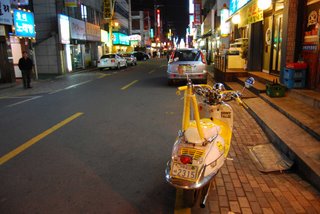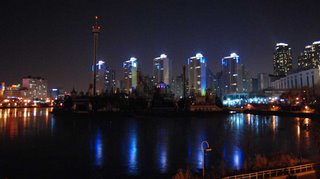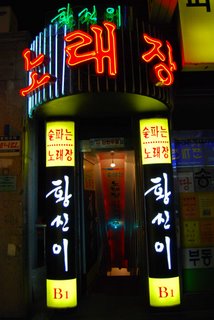
You occasionally check the blog from time to time to see if anything is new, but the same old pictures of random people drinking Cass and eating fried chicken in the snow keep popping up.
Then you check your window (given that you’re in the Northern hemisphere) to make sure that the leaves are still green and the thermostat is still above freezing.
So, this is our final post and it doesn’t even come from South, Korea. We’ve landed in Ann Arbor, Michigan where there are still a lot of Koreans, but considerably less cabbage.
My gut reaction is that it’s nice to be back, but the Mid-West to me is still like going to another country. Norms are a little different, but I can understand what people are saying...for the most part.
The pace of life here is a lot slower than in Seoul, and that will be something that it takes time to get used to. There’s at least one Noraebang in Ann Arbor, otherwise Karaoke is open bar style.
It’s one thing to enjoy you and your friends’ singing—it’s quite another to listen to a love struck couple bellow Nikki French’s “Turn Around” into the entire sports bar.
Thanks for reading,
James & Sarah
 The weather was stormy for our first day in Sokcho, South Korea. Spring marks the beginning of the yellow dust season. The yellow dust is a mixture of pollution and sand blown down from China. The sand is a kind of natural pollution. It's eroded from lands that were once forest. Rapid industrialization and
The weather was stormy for our first day in Sokcho, South Korea. Spring marks the beginning of the yellow dust season. The yellow dust is a mixture of pollution and sand blown down from China. The sand is a kind of natural pollution. It's eroded from lands that were once forest. Rapid industrialization and 
 Usually when you go to the beach, you want the weather to be sunny and warm, but nasty weather in S. Korea is auspicious. It means you can have some personal space. You won't get the beach to yourself, but you'll get enough room to spread out.
Usually when you go to the beach, you want the weather to be sunny and warm, but nasty weather in S. Korea is auspicious. It means you can have some personal space. You won't get the beach to yourself, but you'll get enough room to spread out. 



 Korean rest-stops are happening and filled with all sorts of characters.
Korean rest-stops are happening and filled with all sorts of characters.  The East Seoul Bus terminal is a colorful, busy place.
The East Seoul Bus terminal is a colorful, busy place.







 Summit View
Summit View  No trekking allowed past these posts.
No trekking allowed past these posts. 




 This Lionfish reminded me of Adjoshies
This Lionfish reminded me of Adjoshies Strings of kites in Hangang Park.
Strings of kites in Hangang Park.  One of the many bridges that stretches across the Han River.
One of the many bridges that stretches across the Han River. 







 Advertising climbs along the sides of towers, and some times large cranes are needed to swap out billboards.
Advertising climbs along the sides of towers, and some times large cranes are needed to swap out billboards.



 In some area's of Seoul, building codes allow for apartments to stand for only twenty years. Then the developers must buy out people who own an apartment for the current value of the land.
In some area's of Seoul, building codes allow for apartments to stand for only twenty years. Then the developers must buy out people who own an apartment for the current value of the land. 





 Day slips seamlessly to night in Seoul—home to a culture of people determined to get ahead.
Day slips seamlessly to night in Seoul—home to a culture of people determined to get ahead.
